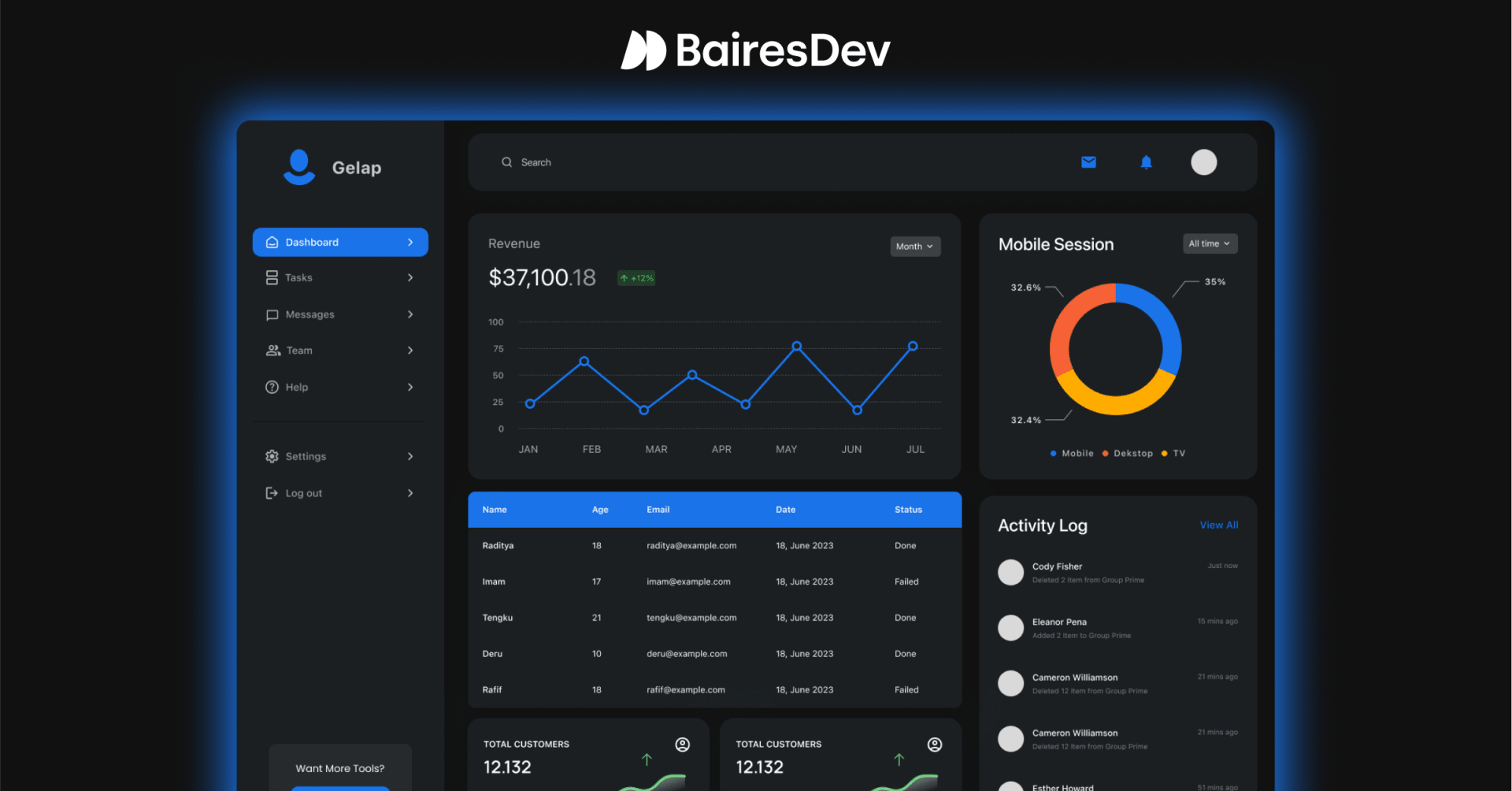PHP is a popular server-side scripting language widely used for web development. It is open-source and relatively easy to learn, which makes it a preferred choice for businesses looking to hire PHP developers for building dynamic and interactive websites. PHP enables these developers to embed code directly into HTML, which facilitates the creation of dynamic web pages and applications.
The language’s significance in web development, particularly for a PHP development company, lies in its versatility, as it can be integrated with various sources including a mySQL database along with content management systems and frameworks. Its robustness and active community support have contributed to its continued popularity in the web development domain.
Understanding PHP Charts and Graph Libraries

PHP chart and graphing libraries are sets of pre-written functions and methods that simplify the process of creating charts and graphs in PHP-based applications. These libraries provide a wide range of customizable options that enable developers to create interactive and dynamic data visualizations effortlessly.
The primary purpose of these libraries is to represent complex data in a visually understandable format. By incorporating charts and graphs, website developers can present data more effectively and allow users to analyze information more intuitively.
Benefits of Using PHP Libraries for Charts and Graphs
Using PHP libraries for charts and graphs offers several advantages that make them indispensable tools in web development projects as PHP libraries come with well-documented APIs and straightforward syntax, which makes it easy for developers to integrate charts and graphs into their applications. PHP chart and graph libraries also support various chart types, such as line charts then, bar charts, and pie charts, that provide developers with flexibility in visualization options.
Why Use PHP Chart & Graphs Libraries?
Charts and graphs play a crucial role in data visualization as it presents complex data in a visually appealing and easy-to-understand format. They aid in identifying patterns along with trends and correlations within data, thereby helping businesses and organizations make informed decisions.
The Importance of Data Visualization
Data visualization holds immense significance in today’s data-driven business world. As data continues to grow in volume and complexity, it becomes increasingly challenging to comprehend and draw meaningful insights from raw numbers. Data visualization bridges this gap by presenting information in a visually intuitive manner, thereby making it easier to grasp and analyze.
Studies show that data visualization enhances data understanding by up to 400%. It aids decision-making processes and uncovers hidden data points and insights which helps in understanding complex data effectively.
Top PHP Charts & Graph Libraries
Let’s look at a few top PHP Chars and Graph Libraries.
#1 pChart – Create Interactive Charts With Ease
pChart is a PHP-based charting library known for its ease of use and interactive features. It has been around since 2004. It has gained popularity for its simplicity and reliability.
Features of pChart
- Support for various chart types that includes line charts, bar charts, bar plots, and scatter plots.
- pChart offers customization options to suit your preferences when it comes to colors and layouts.
- pChart includes built-in functions for convenient data manipulation.
Pros and Cons of pChart
| Pros | Cons |
| Integration into PHP projects. | Limited 3D chart capabilities. |
| Well documented API with solid community support. | Fewer advanced chart types compared to other libraries. |
#2 Chart.js
Chart.js is a widely used client side script that can be easily incorporated into PHP applications. It boasts a range of chart types. Is known for its simplicity and flexibility.
Features
- Multiple chart types are supported by Chart.js like the line chart, bar chart, and radar charts.
- Responsive design ensures display across devices.
- Chart.js offers animations, enhancing the visual appeal of the charts, and making beautiful client side charts..
Pros and Cons
| Pros | Cons |
| Beginner-friendly with easy-to-understand documentation. | Limited advanced customization options. |
| Ideal for small to medium-sized projects. | Less suitable for handling large datasets. |
#3 Google Charts
Google Charts is a web-based charting tool provided by Google. It’s user-friendly and requires minimal coding knowledge.
Features
- Wide variety of chart types including geographical maps.
- Hosted by Google so no need to worry about server load.
- Google Charts provides cross-browser compatibility, ensuring your charts display consistently across different web browsers.
Pros and Cons
| Pros | Cons |
| No setup is required as it is hosted by Google. | Compared to PHP-based libraries it has options for customization. |
| Real time data updates are supported by the library. | An internet connection is required to access Google’s servers. |
#4 phpChart 2.0
phpChart 2.0 is an advanced server side PHP library that enables the creation of interactive charts.
Features
- Support for various chart types including 3D charts.
- Dynamic data updates are facilitated through AJAX.
- phpChart 2.0 also offers user interaction capabilities, such as tooltips and click events, enhancing the user experience of the created charts.
Pros and Cons
| Pros | Cons |
| Extensive customization capabilities are available. | The learning curve may be steeper for beginners. |
| Suitable for handling large datasets. | Certain advanced features might require additional configuration steps. |
#5 Cytoscape.js [Best for Line Charts]
Cytoscape.js is a widely used JavaScript library that allows the creation of network visualizations. It is primarily recognized for network graphs it also offers capabilities for generating line charts due to its flexibility and rich feature set.
Features
- Cytoscape.js specializes in visualizing networks and graph structures.
- Software developers have options to customize the appearance of charts and graphs resulting in stunning visualizations.
- The chart generated using Cytoscape.js automatically adjusts to fit different screen sizes and devices..
Pros and Cons
| Pros | Cons |
| Cytoscape.js excels in visualizing complex data in the form of networks and line charts, providing a unique and dynamic way to present data. | Due to its versatility and advanced features mastering all aspects of Cytoscape.js may require some time and effort. |
| The library comes with well-documented APIs and extensive examples which makes it relatively easy to implement and work with. | While Cytoscape.js handles moderate-sized data sets with ease as extremely large datasets might result in performance issues. |
#6 Flot Charts [Best for Pie Charts]
Flot Charts is a popular jQuery-based charting library that specializes in creating various types of interactive charts including pie and bar charts.
Features
- Flot Charts provide excellent support for creating visually appealing and informative pie, bar and line charts.
- Server side script supports interactive elements and animations that enhance the user experience.
- Flot Charts handles time series data effectively, making it ideal for plotting chronological data or creating trend visualizations.
Pros and Cons
| Pros | Cons |
| Flot Charts can be easily integrated into web applications that makes it suitable for developers of all skill levels. | While Flot Charts excels in pie charts but it might have limitations in creating other complex chart types. |
| The charts created using Flot Charts are responsive and adapt well to different screen sizes. | Compared to some other libraries Flot Charts offers fewer customization options. |
#7 Charts 4 PHP
Charts 4 PHP is a PHP-based charting and drawing library designed to facilitate the creation of dynamic and interactive charts.
Features
- Charts 4 PHP offers support for various chart types including line charts and bar charts.
- The library allows easy integration with various data sources thereby making it convenient to visualize data from databases and APIs.
- Charts 4 PHP also provides an intuitive and user-friendly interface, making it easier for developers to customize and control their charts.
Pros and Cons
| Pros | Cons |
| Charts 4 PHP efficiently handles large datasets which makes it suitable for projects with significant data requirements. | The library’s documentation might not be as extensive as some other PHP charting libraries. |
| The library provides a straightforward implementation process even for developers new to PHP. | While Charts 4 PHP offers customization options it might not have the same level of flexibility as some competitors. |
Choosing the Right PHP Chart & Graphs Library
When selecting a PHP charts and graphs library for a project several factors should be considered.
- Identify the specific visualization needs of the project and choose a library that meets those requirements.
- Consider whether the library can handle the expected amount of data and future growth.
- Opt for a library with a user-friendly interface and well-documented API especially if the developers are relatively new to data visualization.
- Ensure the library has comprehensive documentation to aid in the implementation process.
How to Implement a PHP Chart & Graphs Library
Implementing a PHP chart and graphs library in a PHP code or web development project involves the following general steps.
- Begin by installing the chosen library using Composer or by downloading the necessary files.
- Include the required library files in the PHP project to access its functions.
- Prepare the data that needs to be visualized and structure it appropriately.
- Use the library’s functions to render the desired chart type with the prepared data.
Conclusion
PHP chart and graph libraries play a vital role in efficient data visualization for the typical web programmer, a fact evident in numerous famous PHP websites. These libraries enable developers to present complex data in a visually appealing and understandable format. By choosing the right PHP library (or JS client side scripts) and following the implementation steps, developers can improve their web applications’ user experience and data comprehension. Utilizing data visualization with PHP charts and graphs libraries empowers businesses and organizations to make informed decisions and gain valuable insights from their data.
If you enjoyed this, be sure to check out our other PHP articles.
- Top PHP Dev Tools for Streamlining Your Development Process
- PHP Developer Skills: Mastering the Essentials
- What PHP Frameworks Should You Be Using?
- 3 Reasons Why PHP is Great for Startups
FAQs
What is the advantage of using a PHP chart and graph library?
PHP charts and graph libraries offer numerous advantages such as easy data visualizations and extensive customization options.
How do I choose the best PHP chart and graph library for my project?
When choosing a PHP library you should consider factors such as project requirements with scalability and the library’s documentation.
Are there any free PHP charts and graph libraries?
A few PHP chart and graph libraries are available for free that provide basic functionalities. Some paid options may also offer free tiers or trial versions.
Can I use PHP chart and graph libraries if I’m a beginner in PHP?
Several beginner-friendly PHP chart and graph libraries are available which makes it accessible for developers at all levels of expertise.







